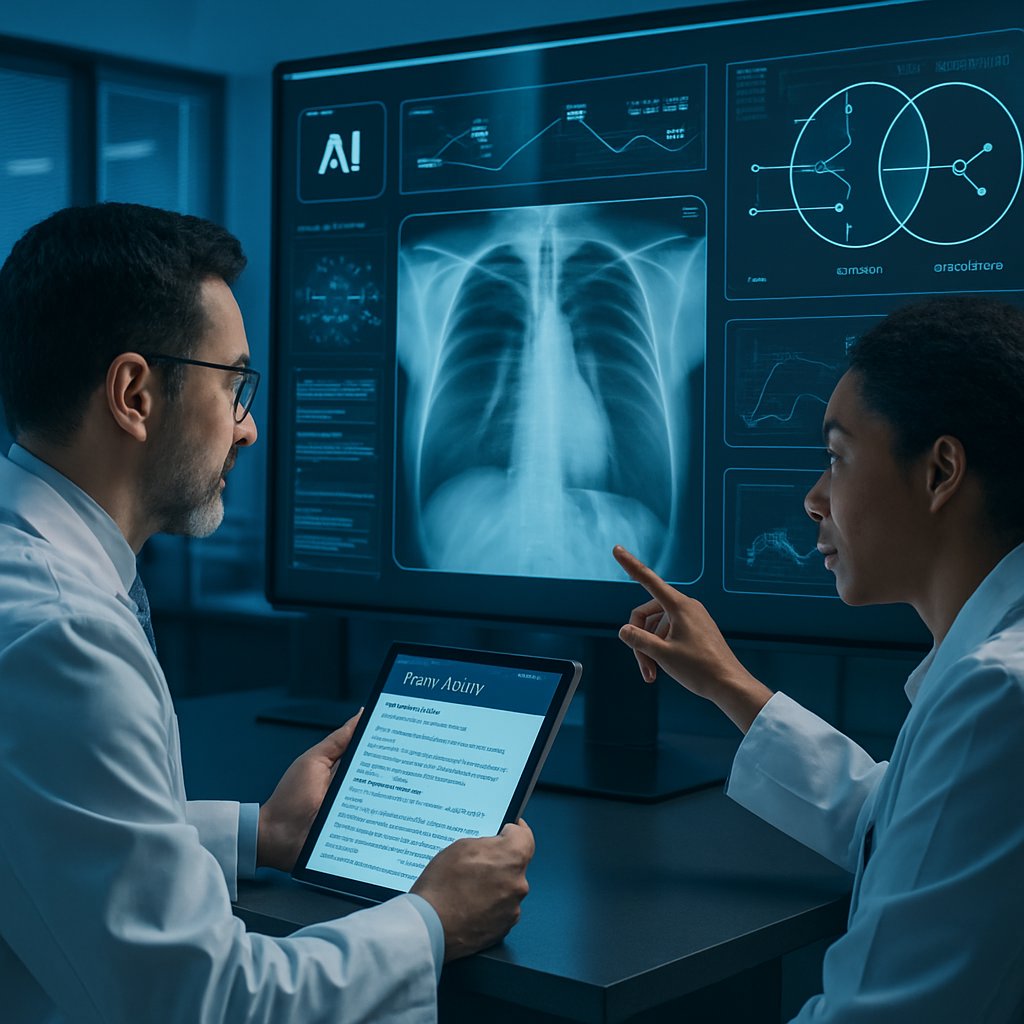Harnessing AI for Better Diagnoses: A Fresh Look at Radiology with Language Model Consensus
In recent years, artificial intelligence (AI) has revolutionized many facets of medicine, and radiology is no exception. With the help of sophisticated large language models (LLMs), radiologists can bolster their diagnostic abilities, especially when interpreting complex medical images like chest X-rays. In a groundbreaking study, researchers Md Kamrul Siam, Md Jobair Hossain Faruk, Jerry Q. Cheng, and Huanying Gu introduced a novel framework that combines the strengths of two leading LLMs—ChatGPT and Claude—to enhance diagnostic reliability. Let's explore how this innovative approach works and what it means for the future of medical imaging!
Understanding the Challenge in Radiology
Radiologists rely not only on images like X-rays, CT scans, or MRIs to diagnose patients but also on the rich clinical context, including the patient's history, symptoms, and physical findings. However, even advanced LLMs sometimes overlook subtle details or make incorrect assumptions—referred to as "hallucinations." With this challenge in mind, the authors of the study set out to create a model-agnostic framework that would harness the power of multiple LLMs to improve diagnostic accuracy.
What Is a Model-Agnostic Framework?
Imagine you have two highly skilled chefs (LLMs) with unique cooking styles (diagnostic approaches). Instead of choosing one chef to prepare your meal (making a diagnosis), you invite both to collaborate. This way, they can blend their skills and insights, leading to a more refined and trustworthy dish (diagnosis). That's the essence of a model-agnostic framework: leveraging multiple LLMs to harness different strengths without needing to modify their fundamental architectures.
The Study Breakdown: How It Works
Data Used
The researchers used the CheXpert dataset, a comprehensive collection of more than 224,000 chest X-rays, to assess the performance of their proposed model. This dataset includes images labeled for 14 different medical findings, such as pneumonia, edema, and lung lesions. To evaluate diagnostic accuracy, they selected a random subset of these X-rays, along with synthetic clinical notes, to represent the real-world clinical context.
Steps in the Framework
Unimodal vs. Multimodal Inputs:
- Unimodal Input: The LLMs analyze the chest X-rays without any accompanying text.
- Multimodal Input: The LLMs analyze both the chest X-ray images and synthetic clinical notes that provide additional context.
Consensus Mechanism: The researchers employed a similarity-based approach, where a consensus is reached between the two models based on their outputs. By setting a high standard (95% similarity), the framework ensures that only high-confidence predictions are accepted.
Parallel Execution: While the two LLMs (ChatGPT and Claude) independently assessed the same images and notes, their predictions were compared. This approach mirrors the common practice in medical settings where multiple opinions are often sought before arriving at a conclusion.
Results: Striking Improvements
From the unimodal analysis, ChatGPT achieved an accuracy of 62.8%, while Claude outperformed it with 76.9%. However, when the researchers included the consensus method, accuracy improved to 77.6%. In the multimodal analysis, ChatGPT soared to 84%, and consensus accuracy leapt to a remarkable 91.3%!
These results illustrate the effectiveness of combining multiple LLMs. They consistently outperformed individual models, showcasing how two "brains" can enhance diagnostic trustworthiness in a significant way.
Real-World Implications
So, what do these findings mean for the practice of radiology? Here are a few key applications:
- Enhanced Diagnostic Support: The proposed framework improves the reliability of AI-assisted diagnostics, reducing the risk of errors.
- Greater Trust in AI: By providing a safety net through consensus, clinicians may feel more comfortable relying on AI outputs, knowing there's a built-in verification process.
- Patient Safety: By flagging ambiguous cases for human review, the framework can help prioritize which cases need expert attention, reducing potential harm.
- Scalability to Other Modalities: While this study focused on chest X-rays, the model could potentially be extended to other imaging modalities, like MRIs or CT scans.
Potential Limitations and Future Directions
While the study presents impressive findings, there are some limitations to consider:
Small Sample Size: The multimodal results were based on only 50 cases with synthetic notes. Future studies will need to examine larger, more diverse datasets to enhance the generalizability of the findings.
Model Diversity: The research showcased only two LLMs. There's a vast array of other models that could be explored to further improve the consensus process.
Interpretability: The focus on accuracy may need to extend to including explanation mechanisms for the decisions made by these models, enhancing clinician understanding and trust.
Key Takeaways
The Power of Consensus: Combining outputs from multiple LLMs enhances diagnostic accuracy and trustworthiness. Think of it as seeking a second opinion from doctors before making a critical health decision.
Multimodal Approach: Integrating both textual and visual information can significantly boost diagnostic performance, which mirrors how medical professionals utilize various types of patient data.
Future of AI in Radiology: The framework opens up avenues for further research and application in clinical settings, contributing to safer, more reliable diagnostic practices.
Practical Implementation: Clinicians can benefit from adopting similar consensus mechanisms in their practice, potentially improving diagnostic confidence and reducing errors.
This innovative research reaffirms that AI can be a powerful ally in modern healthcare, especially when robust frameworks unite the strengths of multiple systems. For medical professionals, understanding these developments can aid in refining their own practices and, ultimately, provide better patient care.

